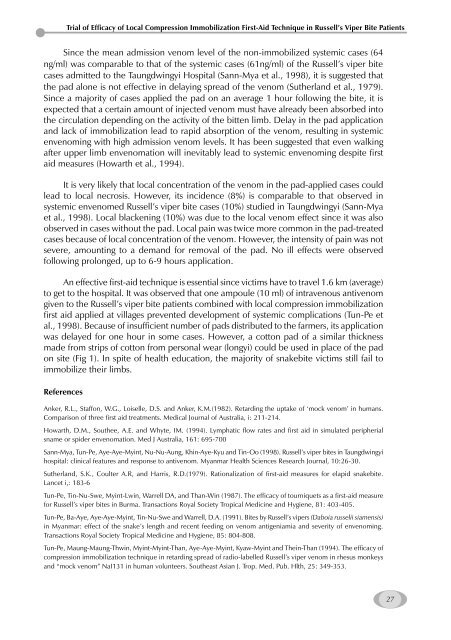Management of Snakebite and Research Management of Snakebite ...
Management of Snakebite and Research Management of Snakebite ...
Management of Snakebite and Research Management of Snakebite ...
You also want an ePaper? Increase the reach of your titles
YUMPU automatically turns print PDFs into web optimized ePapers that Google loves.
Since the mean admission venom level <strong>of</strong> the non-immobilized systemic cases (64<br />
ng/ml) was comparable to that <strong>of</strong> the systemic cases (61ng/ml) <strong>of</strong> the Russell’s viper bite<br />
cases admitted to the Taungdwingyi Hospital (Sann-Mya et al., 1998), it is suggested that<br />
the pad alone is not effective in delaying spread <strong>of</strong> the venom (Sutherl<strong>and</strong> et al., 1979).<br />
Since a majority <strong>of</strong> cases applied the pad on an average 1 hour following the bite, it is<br />
expected that a certain amount <strong>of</strong> injected venom must have already been absorbed into<br />
the circulation depending on the activity <strong>of</strong> the bitten limb. Delay in the pad application<br />
<strong>and</strong> lack <strong>of</strong> immobilization lead to rapid absorption <strong>of</strong> the venom, resulting in systemic<br />
envenoming with high admission venom levels. It has been suggested that even walking<br />
after upper limb envenomation will inevitably lead to systemic envenoming despite first<br />
aid measures (Howarth et al., 1994).<br />
It is very likely that local concentration <strong>of</strong> the venom in the pad-applied cases could<br />
lead to local necrosis. However, its incidence (8%) is comparable to that observed in<br />
systemic envenomed Russell’s viper bite cases (10%) studied in Taungdwingyi (Sann-Mya<br />
et al., 1998). Local blackening (10%) was due to the local venom effect since it was also<br />
observed in cases without the pad. Local pain was twice more common in the pad-treated<br />
cases because <strong>of</strong> local concentration <strong>of</strong> the venom. However, the intensity <strong>of</strong> pain was not<br />
severe, amounting to a dem<strong>and</strong> for removal <strong>of</strong> the pad. No ill effects were observed<br />
following prolonged, up to 6-9 hours application.<br />
An effective first-aid technique is essential since victims have to travel 1.6 km (average)<br />
to get to the hospital. It was observed that one ampoule (10 ml) <strong>of</strong> intravenous antivenom<br />
given to the Russell’s viper bite patients combined with local compression immobilization<br />
first aid applied at villages prevented development <strong>of</strong> systemic complications (Tun-Pe et<br />
al., 1998). Because <strong>of</strong> insufficient number <strong>of</strong> pads distributed to the farmers, its application<br />
was delayed for one hour in some cases. However, a cotton pad <strong>of</strong> a similar thickness<br />
made from strips <strong>of</strong> cotton from personal wear (longyi) could be used in place <strong>of</strong> the pad<br />
on site (Fig 1). In spite <strong>of</strong> health education, the majority <strong>of</strong> snakebite victims still fail to<br />
immobilize their limbs.<br />
References<br />
Trial <strong>of</strong> Efficacy <strong>of</strong> Local Compression Immobilization First-Aid Technique in Russell’s Viper Bite Patients<br />
Anker, R.L., Staffon, W.G., Loiselle, D.S. <strong>and</strong> Anker, K.M.(1982). Retarding the uptake <strong>of</strong> ‘mock venom’ in humans.<br />
Comparison <strong>of</strong> three first aid treatments. Medical Journal <strong>of</strong> Australia, i: 211-214.<br />
Howarth, D.M., Southee, A.E. <strong>and</strong> Whyte, IM. (1994). Lymphatic flow rates <strong>and</strong> first aid in simulated peripherial<br />
sname or spider envenomation. Med J Australia, 161: 695-700<br />
Sann-Mya, Tun-Pe, Aye-Aye-Myint, Nu-Nu-Aung, Khin-Aye-Kyu <strong>and</strong> Tin-Oo (1998). Russell’s viper bites in Taungdwingyi<br />
hospital: clinical features <strong>and</strong> response to antivenom. Myanmar Health Sciences <strong>Research</strong> Journal, 10:26-30.<br />
Sutherl<strong>and</strong>, S.K., Coulter A.R, <strong>and</strong> Harris, R.D.(1979). Rationalization <strong>of</strong> first-aid measures for elapid snakebite.<br />
Lancet i,: 183-6<br />
Tun-Pe, Tin-Nu-Swe, Myint-Lwin, Warrell DA, <strong>and</strong> Than-Win (1987). The efficacy <strong>of</strong> tourniquets as a first-aid measure<br />
for Russell’s viper bites in Burma. Transactions Royal Society Tropical Medicine <strong>and</strong> Hygiene, 81: 403-405.<br />
Tun-Pe, Ba-Aye, Aye-Aye-Myint, Tin-Nu-Swe <strong>and</strong> Warrell, D.A. (1991). Bites by Russell’s vipers (Daboia russelii siamensis)<br />
in Myanmar: effect <strong>of</strong> the snake’s length <strong>and</strong> recent feeding on venom antigeniamia <strong>and</strong> severity <strong>of</strong> envenoming.<br />
Transactions Royal Society Tropical Medicine <strong>and</strong> Hygiene, 85: 804-808.<br />
Tun-Pe, Maung-Maung-Thwin, Myint-Myint-Than, Aye-Aye-Myint, Kyaw-Myint <strong>and</strong> Thein-Than (1994). The efficacy <strong>of</strong><br />
compression immobilization technique in retarding spread <strong>of</strong> radio-labelled Russell’s viper venom in rhesus monkeys<br />
<strong>and</strong> “mock venom” NaI131 in human volunteers. Southeast Asian J. Trop. Med. Pub. Hlth, 25: 349-353.<br />
27









